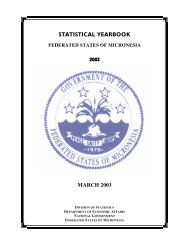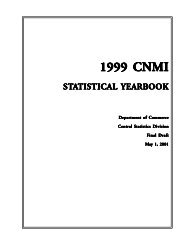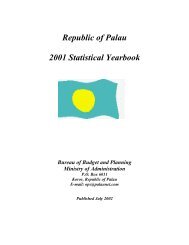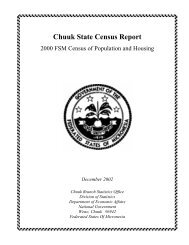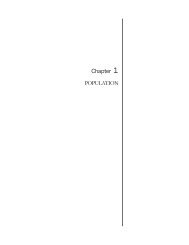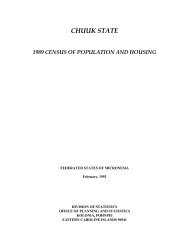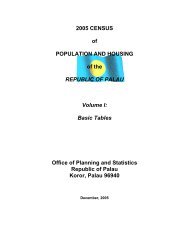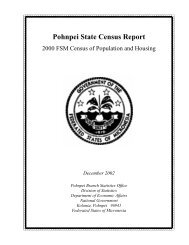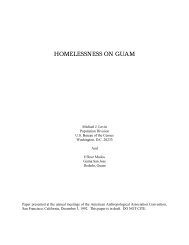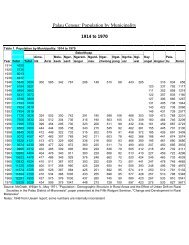A Statistical Overview of Ebeye - Part Two - pacificweb.org
A Statistical Overview of Ebeye - Part Two - pacificweb.org
A Statistical Overview of Ebeye - Part Two - pacificweb.org
You also want an ePaper? Increase the reach of your titles
YUMPU automatically turns print PDFs into web optimized ePapers that Google loves.
A <strong>Statistical</strong> <strong>Overview</strong> <strong>of</strong> <strong>Ebeye</strong><strong>Part</strong> <strong>Two</strong>: Elementary School AttendanceBy Ben Graham and Charles Paul(This is the second in a series <strong>of</strong> short essays focusing on social and economic changes on the island <strong>of</strong> <strong>Ebeye</strong> 1 )The RMI recognizes education as one <strong>of</strong> its pillars <strong>of</strong> national development and has made access to basiceducational services a fundamental right <strong>of</strong> all its citizens. The RMI Constitution, in the Bill <strong>of</strong> Rights(Article II, Section 15), states: “The Government <strong>of</strong> the Marshall Islands recognizes the right <strong>of</strong> thepeople to health care, education, and legal services and the obligation to take every step reasonable andnecessary to provide these services.” As such, education is compulsory for children aged six to 14 (theelementary school age), meaning that every child must attend school at least until he or she completes theeighth grade.However, over the past several decades, a disturbing trend has emerged: an increasing percentage <strong>of</strong>school age children are not attending school. This essay analyzes school attendance on <strong>Ebeye</strong>, the RMI’ssecond most populated island, using census data collected since the late 1960s.The “JS” on <strong>Ebeye</strong>: Gaining in NumbersA child who does not attend school is <strong>of</strong>ten referred to in Marshallese as a “JS” for “jab school,” whichtranslates as “doesn’t attend school.” The very existence <strong>of</strong> such a term suggests that non-attendance hasbecome quite common throughout the islands. Statistics confirm this.Nationally, while educational attainment among adults has generally improved over time, the elementaryschool attendance rate has steadily declined. As <strong>of</strong> 1999, the number <strong>of</strong> children not in school in the RMIhad increased to over 2,000.<strong>Ebeye</strong> School Attendance (ages 6 to 14): 1967 to 1999Subject 1967 1973 1980 1988 1999Population 6 to 14 980 1,303 1,562 2,532 2,340Attended school 749 1,176 1,416 2,211 1,928DID NOT attend 231 127 146 321 412Attendance rate 76.4 90.3 90.7 87.3 82.4Source: Insular Areas <strong>Statistical</strong> Enhancement ProgramOn <strong>Ebeye</strong>, the elementary age populationmore than doubled between 1967 and 1999,from 980 to 2,340. Interestingly, theelementary age population decreased byabout 200 (almost 10%) between 1988 and1999, most likely the result <strong>of</strong> decreasedfertility and out-migration.On the whole, the percentage <strong>of</strong> children attending school (the attendance rate) on <strong>Ebeye</strong> improvedslightly between 1967 and 1999. However, after peaking at over 90% in the 1970s and 1980s, the rate hassince declined. As <strong>of</strong> 1999, the rate had fallen to just 82%, translating into over 400 children (almost18%) not in school.Contributing FactorsSeveral factors may account for the decreasing attendance rate on <strong>Ebeye</strong>. The first and most obviousfactor may be lack <strong>of</strong> space. <strong>Ebeye</strong>’s handful <strong>of</strong> elementary schools may simply not have space for all thesix-year olds coming up every year, just as the RMI’s three public high schools do not have enough roomfor entering freshmen, as highlighted by a recent Marshall Islands Journal article. In other words, it isquite possible that high fertility rates have outpaced any growth in classroom space.1 For those who do not already know, <strong>Ebeye</strong> Island, in Kwajalein Atoll, is the second most populated island in the RMI. Nearly10,000 Marshallese reside on <strong>Ebeye</strong>, many <strong>of</strong> whom work on the Ronald Reagan Ballistic Missile Defense Test Site.
A second factor may be motivational; families and students themselves may not be placing enoughimportance on the value <strong>of</strong> education. Often, people do not recognize the increased employment andearning potential (among other benefits) that schooling provides.<strong>Ebeye</strong> Children Not in School (ages 6 to 14):1967 to 19994504003503002502001501005001967 1973 1980 1988 1999Urban migration may be a third factor. Over the past several decades, hundreds <strong>of</strong> families have relocatedto <strong>Ebeye</strong> from neighboring atolls, mostly in search <strong>of</strong> employment. These families <strong>of</strong>ten bring with themchildren who may encounter difficulty getting into already crowded schools, or who may have neverattended school before (and are therefore unlikely to start).The Future?Any child, anywhere in the RMI, who does not attend school will almost certainly face disadvantageslater in life. People with lower levels <strong>of</strong> education (or none at all) are much less likely to get hired and, ifthey are fortunate enough to get a job, earn wages far below their more educated co-workers.But children who grow up in an urban setting like <strong>Ebeye</strong> and who do not attend school will be especiallydisadvantaged. Because these children reside in an urban setting (versus a rural, or outer island setting),they forego the opportunity to attain a traditional education (the “opportunity cost”). Living on <strong>Ebeye</strong>,these children may not have the chance to learn some <strong>of</strong> the important traditional skills that have helpedMarshallese live and thrive in the coral atoll environment. At the same time, because these children arealso not attending school, they do not attain a western education.As a result, these children learn neither traditional nor western skills, a circumstance that will, withoutquestion, make basic social and economic survival difficult in any environment, urban or rural.As these children grow older, what stations in life will they occupy? Will they become productivemembers <strong>of</strong> the community who will contribute to the growth and development <strong>of</strong> their island? Or willthey become the proverbial “idle hands” <strong>of</strong> society? These are the difficult questions that need to beaddressed.Conclusion<strong>Ebeye</strong>’s low elementary attendance rate should cause great concern. Even more alarming, however, is thefact that this rate has been on a steady decline since the early 1980s – and according to statistics from themost recent survey conducted on <strong>Ebeye</strong>, the 2002 Household Income and Expenditure Survey, the2
attendance rate has not changed much since 1999. Out <strong>of</strong> 414 school aged children covered in the survey,only 85% were attending school.This is, therefore, both a long-term and worsening crisis for <strong>Ebeye</strong>. Immediate measures must be taken toreverse this trend and to ensure that all <strong>of</strong> <strong>Ebeye</strong>’s children have access to basic education.After all, it is the law.An aerial view <strong>of</strong> <strong>Ebeye</strong> Island. Total land mass: 0.14 square miles.Special thanks to Dr. Michael LevinNote: This essay is produced under the auspices <strong>of</strong> the Insular Areas <strong>Statistical</strong> Enhancement Program and is not an <strong>of</strong>ficial RMI or US Census Bureau report.For questions or comments, email: benjamin.m.graham@census.gov3



